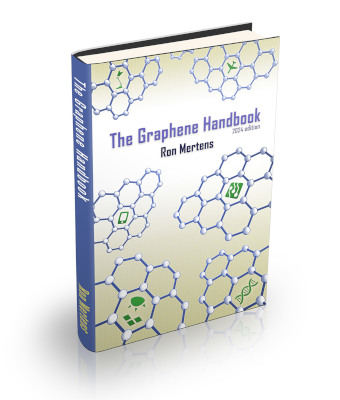The Graphene-Info newsletter, Febraury 2019
Published: Tue, 02/05/19
Graphenea, AMO and Emberion to take part in a bringing graphene short-wave infrared (SWIR) detectors to market
Graphenea, AMO and Emberion have been approved a European Innovation Council Fast Track to Innovation (FTI) project to help bring to market the G-IMAGER, a graphene imager based on graphene-on-wafer technology. The G-Imager is a short-wave infrared (SWIR) detector for applications in semiconductor inspection, sorting systems, spectroscopy hyperspectral imaging and surveillance.
The collaborating companies are tasked with constructing and marketing the G-Imager which will bring core prices down significantly, allowing market volumes to grow substantially. The G-Imager will be based on the scientifically proven operation of a graphene channel coupled to nanocrystal light absorbers. The nanocrystals serve the function of strong light absorbers for high efficiency, whereas the graphene channel efficiently transports the generated charge to electrical contacts for detection.
The benefits of G-Imager compared to other SWIR detectors, apart from the dramatic cost reduction, will be a lack of cooling requirements, low noise, large dynamic range, broad spectral range and scalable pixel size. These benefits will encourage quick market uptake of the product beyond the project duration, which is 24 months.
Saint Jean Carbon is developing graphene gel salt water batteries
Saint Jean Carbon has announced that it is developing a new form of graphene battery technology and will start building the first prototype of its graphene gel salt water batteries. Batteries based on this technology should charge faster, run longer and theoretically may last indefinitely. The project’s long term goal is to have a series of three full production batteries ready for launch in spring 2020.
Saint Jean Carbon stated that salt water battery technology has been in research for about 5 years. Continued advancement slowed due to limited voltage capacity in comparison with Lithium batteries. Now with the use of graphene in a highly concentrated salt water gel, graphene can now be used without worrying about the graphene re-stacking, which would reduce the intercalation rate. Salt water batteries are much safer, won’t burn and have significantly less raw material cost.
Researchers use bacteria to create a graphene oxide based water filter that kills bacteria
Researchers from Washington University have designed a novel membrane technology that purifies water while preventing biofouling, or buildup of bacteria and other harmful microorganisms that reduce the flow of water. They used graphene and bacteria to build these filtering membranes.
The team developed an ultrafiltration membrane using graphene oxide and bacterial nanocellulose that they found to be highly efficient, long-lasting and environmentally friendly. If their technique were to be scaled up to a large size, it could benefit many developing countries where clean water is scarce.
Gratomic to launch new graphene-enhanced tires
Gratomic has announced the development of new Graphene Ultra Fuel Efficient Tires (GUET) with certification and terrain testing targeted for completion in Q3, 2019. In March 2018, Gratomic announced that it is expecting to commercialize graphene-enhanced tires as a result of its advanced R&D program to include plasma-generated graphene in tires to increase their strength and reduce their.
Gratomic reports that it has been able to reach this point through a unique collaboration agreement with its development partner Perpetuus Carbon Technologies who currently supplies substantial quantities of surface modified graphenes on a monthly basis to the tire industry through its Patented Plasma Process.
The Graphene Handbook, 2019 edition
Graphene-Info is proud to present the new edition of The Graphene Handbook. This book is a comprehensive guide to graphene technology, industry and market.
Reading this book, you'll learn all about:
- The properties of graphene
- Different production methods
- Possible graphene applications
- The latest graphene research
- The current market for graphene materials and products
- The main graphene challenges
- Other promising 2D materials
The graphene book also provides:
- A history of graphene developments
- A graphene investment guide
- An introduction to graphene metrology and standardization
- A comprehensive list of graphene companies
- A guide to other carbon allotropes
Graphene-Info's Market Reports now updated to January 2019
This month we published new versions of all our graphene market reports - the Batteries, Supercapacitors, Graphene Oxide, Lighting, Displays and Graphene Investments market reports are now fully updated!
Graphene-Info provides comprehensive niche graphene market reports, covering everything you need to know about these niche markets.
Researchers from ICN2, IMB-CNM, CSIC, IDIBAPS, and ICFO have designed a graphene-based implant able to record electrical activity in the brain at extremely low frequencies and over large areas.
Researchers at MIT have produced a catalog of the exact sizes and shapes of defects and holes that would most likely be observed (as opposed to the many more that are theoretically possible) when a given number of atoms is removed from the atomic lattice.
A collaborative research team has discovered that when graphene is integrated with the metal of a circuit, contact resistance is not impaired by humidity. This finding may help to develop new sensors with a significant cost reduction.
Researchers from Italy's ISOF-CNR, University of Naples "Federico II" and Università di Modena e Reggio Emilia have developed new organic n-type FET transistors (OFETs) based on CVD graphene sheets.
Researchers from Northwestern University have turned graphene oxide (GO) into a soft, moldable and kneadable "play dough" that can be shaped and reshaped into free-standing, three-dimensional structures.
Researchers have fully characterized graphene nanoribbons (GNRs) with a clear route towards upscaling the production.
Researchers from Queen Mary University of London have shown that graphene exhibits very different properties in humid conditions.
Do you have a friend or a colleague that might be interested in Graphene technology? Forward this mail to update him on the world of Graphene.
If you received this email from a friend, subscribe to this newsletter here!








